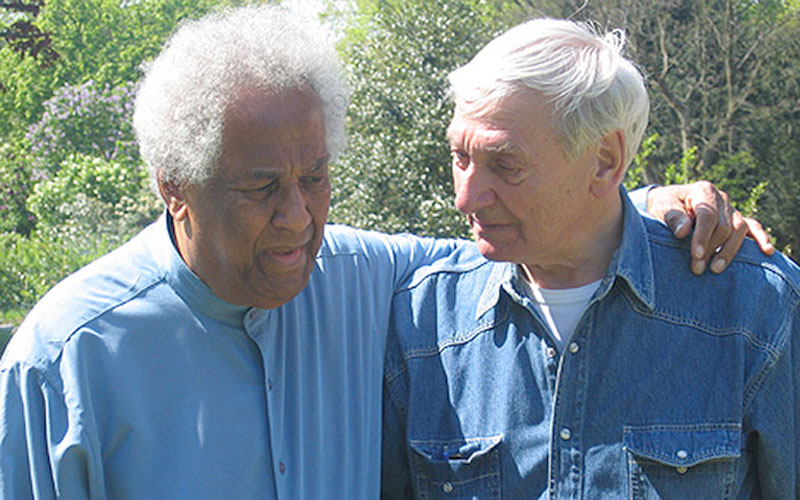BBC London’s Special Correspondent Kurt Barling traveled with former RAF Navigator Cy Grant to the town where two of his fellow crew members were killed in June 1943.
Night after night bomber command sent hundreds of bombers towards targets in Germany.
The strategy of saturation bombing to foreshorten the war was a controversial one, targeting as it did so many civilians in German cities, like Hamburg, Frankfurt, Cologne, Nuremberg and above all the infamous raids on Dresden.
Cy Grant ended his two years of officer training in early 1943. He was to join the crew of the Lancaster bomber W4827 as the attacks on Germany’s industrial heartland of the Ruhr mounted.
During this campaign Bomber Command lost around 19,000 airmen, approximately a third of the total losses during the war of 54,378.
The bombing raid on 25 June 1943 was as hazardous as any. Flying high enough to avoid the anti-aircraft defences meant bitter cold. The air gunner had to be constantly alert for German fighters.
Having reached the target of Gelsenkirchen and successfully dropped their bomb load, pilot Al Langille turned for the dangerous trip home. In the early hours of 26 June whilst over Holland the Lancaster was attacked by a German fighter and what seemed like a short hop home, turned into an instant order to bail out.
Unfortunately for the crew, the escape hatch was damaged and couldn’t be opened. But before they had a chance to contemplate what other action to take to get out of the stricken bomber a huge explosion blew the plane to pieces.
“Suddenly I was falling in space and it was like a dream world. I remember being buffeted by the wind and being jolted as the parachute opened. You could hear dogs barking and then the next sensation was a huge shadow looming up in front of you and that was the earth. I hit the ground and began to gather up my parachute as quickly as I could. I found a place in the soft earth of a canal to bury it in case the Germans found it”.
Cy Grant’s description captures the drama of the moment as he realised he was now in occupied Europe.
Two of his fellow crew members didn’t survive the descent. Another four landed at a distance from him. They were all to end up as prisoners of war. Cy Grant was sent to Stalag Luft III. He was in the camp when the famous tunnels of Tom, Dick and Harry were used to spring the so-called Great Escape.
Now 89, Cy Grant explained all this to me in the field outside the small Dutch town of Nieuw Vennep where he landed. By a miracle he’d missed the canal, and possible drowning, by a couple of feet.
Pointing in the southerly direction where he made a dash for cover in the crops nearly 65 years ago, the farmhouse he took refuge in is still clearly visible. Even more extraordinarily the current owner is the son of Mrs Bulk who tended Grant’s wounds in 1943. Mrs Bulk was seven months pregnant with the current owner back then.
Visiting the farmhouse for the first time in 65 years turned out to be an emotional experience. Mr Bulk recalled how his mother had repeated the story so often of the British serviceman who they had tended and then been taken by the Germans that he practically felt like he’d been there in person.
Grant eagerly sought out the spot where the local police officer had placed him on the back of a motorbike so he could be collected by German forces.
Cy Grant recalls this is the first time during the war where he felt being black was a liability. “I mean I was on the back of the motorbike and the Dutch policeman had a revolver in an open holster. I thought should I take it. He turned to me and said I wouldn’t do that if I were you or words to that effect. It was at that moment that it occurred to me that escape would be pretty futile. Here I was with my blue RAF uniform and a black man. You couldn’t stand out more obviously than that.”
In fact the German press made something of Grant’s colour. A newspaper headline described him as an airman of indeterminate race, as if to say look who the British are using to fight their battles.
But there were others on the ground, and who still live close by to the crash site, who remember Lancaster W4827 coming down. Joost Klootwijk was just 11 when parts from the aricraft rained down on his small town. One engine fell through the roof of the Groenveld’s farmhouse, killing Mrs Groenveld outright.
Racing round on his bicycle in the early hours after the crash happened, left a huge impression on the young Dutch boy. “Night after night you would hear the sound in the distance getting closer and closer. Then it was overhead for between 15 minutes and half an hour. Hundreds and hundreds of bombers, all with four engines, it was so loud. Sometimes in the darkness you laid there in fear. But you knew that these men were liberators. I decided years later that I had to find out what happened to those men and I started with Cy Grant’s Lancaster.”
Indeed, we know so much about what happened to Cy Grant’s Lancaster and hundreds of other downed aircraft because so many Dutch people have made it their business to find out. For the team at the Air Crash museum in Aalsmeer the volunteers search for answers because they believe they owe a debt of gratitude to those aircrews.
Piecing together the stories of the 6,500 aircraft that were lost over the Netherlands is just part of the repayment. It’s believed there are still over 2000 aircraft buried in Dutch soil. This museum, which flies the RAF Ensign, is almost exclusively devoted to the air war over the Netherlands and the allied casualties and lost craft that landed on Dutch territory.
Joost Klootwijk is one of these volunteers. He made contact with Cy Grant last year after writing a book about the story of the last flight of Lancaster W4827. Klootwijk, who is a retired airline worker himself from the Dutch airline KLM, has researched dozens of crash sites close to the Schiphol international airport outside Amsterdam.
During WWII it was an important base for the Luftwaffe and the fighter jet that down Cy Grant’s Lancaster probably came from there. The details of all the crashes are extraordinarily still being sought out by family members of the lost crews all these years after the end of the Second World War.
The war may be long over but many questions still remain for the relatives of those still missing in action.
I asked Joost Klootwijk during our conversation what it meant to finally meet Cy the airman who fell on his village 65 years earlier. The reaction was unexpected.
The 76-year-old Dutchman broke down in floods of tears. Comforted by his wife the only words he could utter were “very emotional”. Like many of his generation he believes that the liberation and peace these men fought and died for should be remembered. There was something of the small boy finally expressing his gratitude with tears.
British Bomber Command crew veterans and their families are now asking that a permanent memorial be raised in London to accord the same respect for these men as given by the likes of the Dutch.
John and Mike Lewis were six and seven respectively when their father was killed aboard a Lancaster shortly after Cy Grant’s plane came down.
I met them at the Air Crash museum which is close by their father’s grave. There is a sense of bitterness from these families that they have to come to the Netherlands to pay their respects to their father annually rather than at a memorial where they might see his name in London.
Robin Gibb speaks passionately about the need for such a token of appreciation and remembrance. I met him at the church of St Clement Danes which is the RAF memorial church. “It’s about support and recognition for what is morally right. We need to be loud and proud for those young lads who laid down their lives to give us the peace that has endured all these years.”
St Clement Danes actually holds all the names of airman who have died in the service of the RAF and this year celebrates its 50th year as the RAF’s “home” church.
Outside, the statue of Air Marshall Sir Arthur “Bomber” Harris is a reminder of the role he played in developing a strategy which was to leave a legacy of controversy. It is this which has perhaps blighted the efforts to remember the sacrifices of these men in the same way as other servicemen and women who lost their lives.
It is ironic that in this week’s Liberation Day commemorations in the Netherlands so much emphasis is put on aircrews as liberators.
Cy Grant was genuinely moved by the reception he received in the Netherlands. He feels it contrasts with the usual treatment he gets in Britain.
Firstly, there are usually raised eyebrows when he says he was an RAF officer during the war. It is often overlooked just how many Commonwealth serviceman, Cy is originally from Guyana in the Caribbean, volunteered for active service on the battlefields of Europe.
He also feels that most people in Britain are now dismissive of the generation who fought against Nazi tyranny and a memorial is long overdue:
“These young men fought for peace not for the perpetuation of war. So any memorial should be seen not as a war memorial but as a peace memorial. These men lost their lives and we fought for Peace.”

